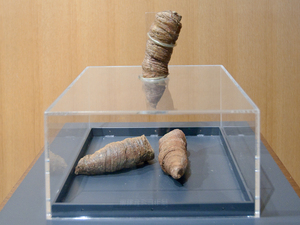Nagoya City Science Museum
TOP > Exhibition Guide > Floor Map> Coral fossil(Heilophyllum sp.)
Coral fossil(Heilophyllum sp.)



Purpose of Exhibition
This exhibit is designed to let you know that the past Earth's rhythms remain in life.
Additional Knowledge
Monadelphous (stand-alone) corals live individually as the name implies, unlike the other kinds of corals that live together to form coral reefs. These monadelphous corals on exhibit have not only annual growth rings but also daily growth rings (Photo 2). The fine lines are their daily growth rings. In 1963, a scholar named "Welles" discovered, by counting those daily growth rings, that there were about 400 days in a year 350 million years ago. Similar researches conducted thereafter with the use of bivalves and stromatolites revealed "the number of days in a year" in the other eras. As a result, it was understood that "the number of days in a year" had gradually decreased as the eras had rolled by (Graph). It is recognized that the Earth's orbital period is almost constant. So it means that the Earth's rotation has been slowing. In other words, the Earth's rotation has been in the process of being braked.The Moon has been acting as a brake on the Earth's rotation. Specifically, the tidal bulge caused by the Moon's gravitational pull creates a friction between the ocean bottom and itself, which works as a brake. The Moon puts a brake on the Earth's rotation and its effect gouges into the bodies of the living things. How mysterious it is!It may be a little bit of a stretch to mention this, but the Earth's rotation seems to have changed as shown in solid line. This way of thinking does come into line with the past geographic distribution of the Continents. Specifically, when the Continents aggregated, the Earth's rotation slowed substantially, but when the Continents separated, the Earth's rotation did not slow easily. In fact, so many phenomena were intertwined in this matter that it is hard to give a simplified explanation. But it will not go wrong to interpret this matter as follows: When the Continents started to separate, the oceans made inroads into the lands, thus creating the shallow seas. The more shallow seas (subjected to a high friction caused by the tide) were formed, the more susceptible the Earth's rotation became to being braked.
This is just another coral fossil. Continued data accumulation and cross-references to other related data, however, make it possible to presume a wide variety of things. You could discover, in your immediate surroundings as well, a clue to probing into the past global environments.
Article by Shoji Nishimoto, curator
